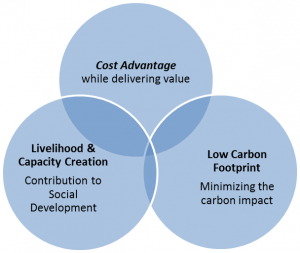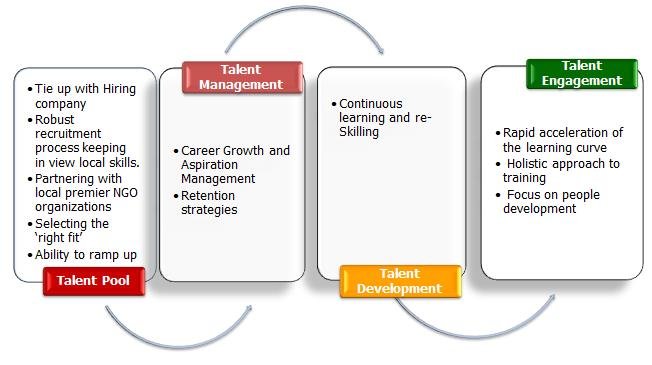The idea of delivering business value as an outsourcing partner to corporates – together with building social value on the edifice of creating rural livelihood – in itself is unique in that it pushes creation of more social enterprises like B2R – and thereby fosters further a new kind of ‘conscious capitalism’ – possibly a more powerful model than its predecessor with the potential to change the business and social landscape of how tremendous value can be created for all stakeholders. The manner in which we have implemented this idea further differentiates us – Some key levers help us differentiate and create a more compelling value proposition viz.:
The innovative service delivery model which, by design, delivers high-quality services at a low-cost footprint. The clusters of rural delivery centers in a hub-and-spoke model are of relatively smaller size built on the principle of decentralized self-reliant service centers and centralized work distribution and aggregation. The size of a center has been designed keeping in mind the opportunities and limitations of rural infrastructure and the location of centers is planned such that employees can walk to his or her place of work. This model has been made possible because of the learnings and extensive experience of the core team in setting up and running third-party BPO delivery centers in their previous work lives. The total BPO experience of this team exceeds 30 person-years and their experience overall in relevant industries is 100 person-years.
Appropriate elements of technology for power backup, internet connectivity and data security have been put together to create technology infrastructure in line with customers’ expectations and comparable to urban centers without the exorbitant costs that come from infrastructure components of urban delivery centers. Scaling up will leverage a robust and secure technology-based central nervous system which seamlessly connects the ‘small centers to build an ‘intelligently-connected large-scale service capability’.
A robust set of people processes, comprising recruitment, and processes for people practices, has been created, keeping in view the local context. The talent pool is rich and vast in terms of potential. Being fresh, however, they need to be molded to the mindset of the clients they service. The design includes leveraging local partners like specific NGOs to be able to create the appropriate reach to potential candidates as well as to create an effective interview process. We are also in the process of developing mechanisms to encourage skill development in these candidates based on the outcome of the recruitment process, even if a particular candidate is not immediately offered a job. This will facilitate skill development in a broader context within the region.
A traditional focus towards education has helped create the foundation of good literacy levels in Uttarakhand (72%) which are better than the national average – a rigorous training & development process has been designed on this foundation to accelerate learning & achieve performance excellence. A holistic approach to training has been taken which starts with building the need-to-learn and addressing that need in a practical manner.
The operational design has being done keeping the social objectives in mind, e.g. we see ourselves moving significantly over to a 3-hour shift based work. This would provide an individual the framework and flexibility to earn in a manner that is non-disruptive since s/he could continue with other obligations or family responsibilities.




